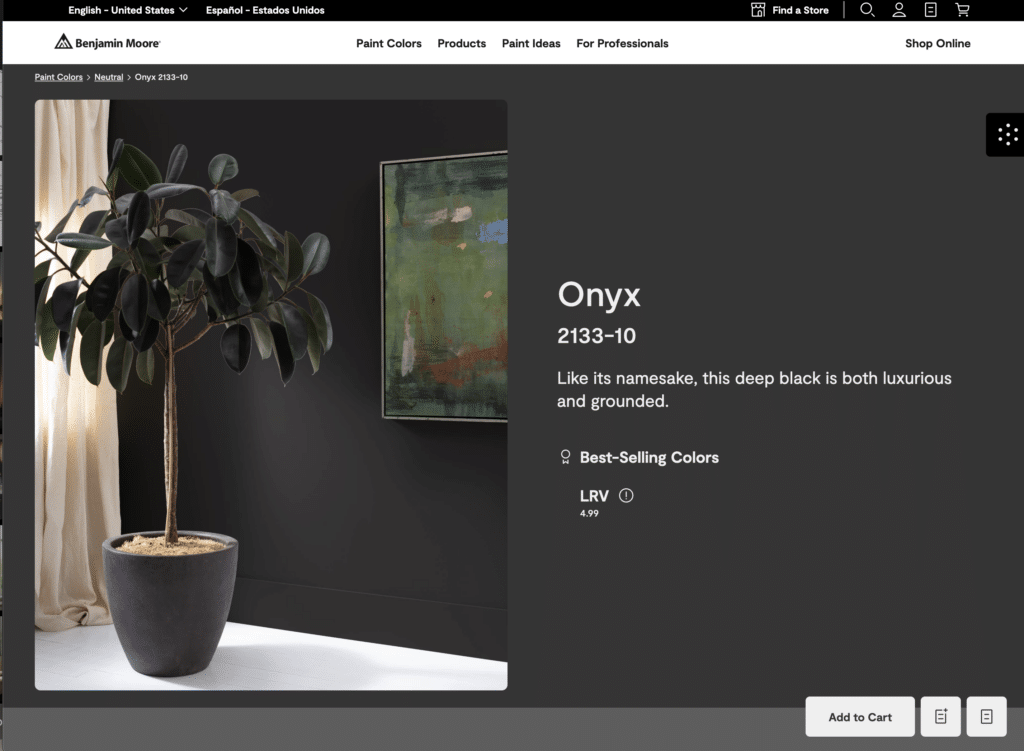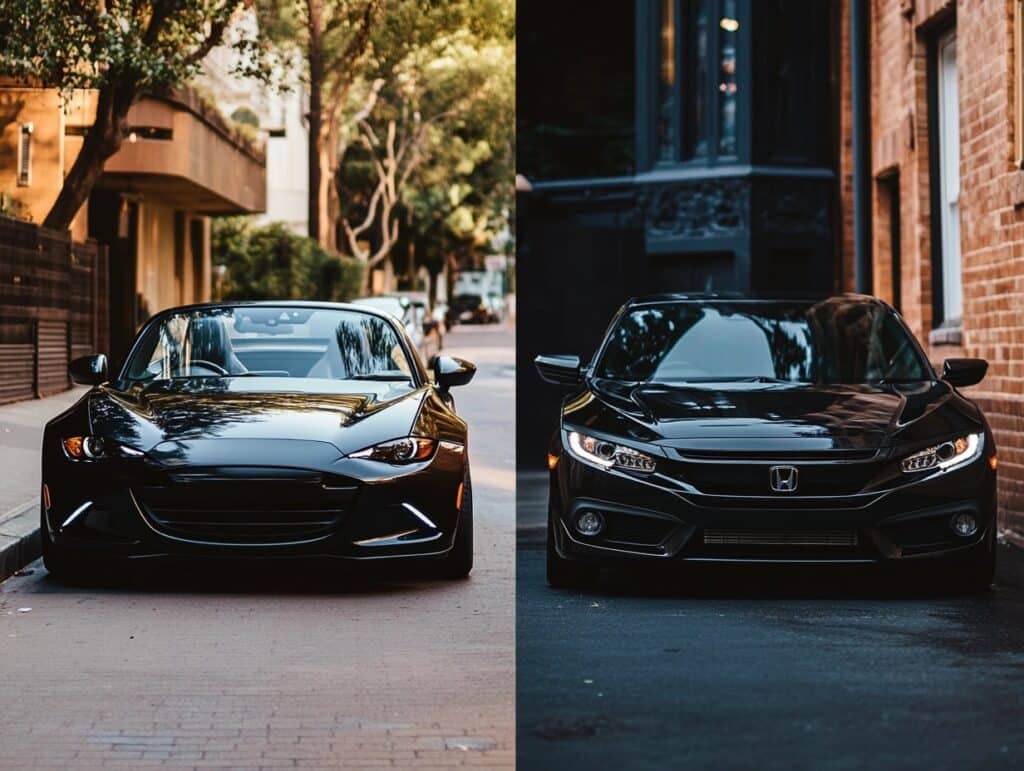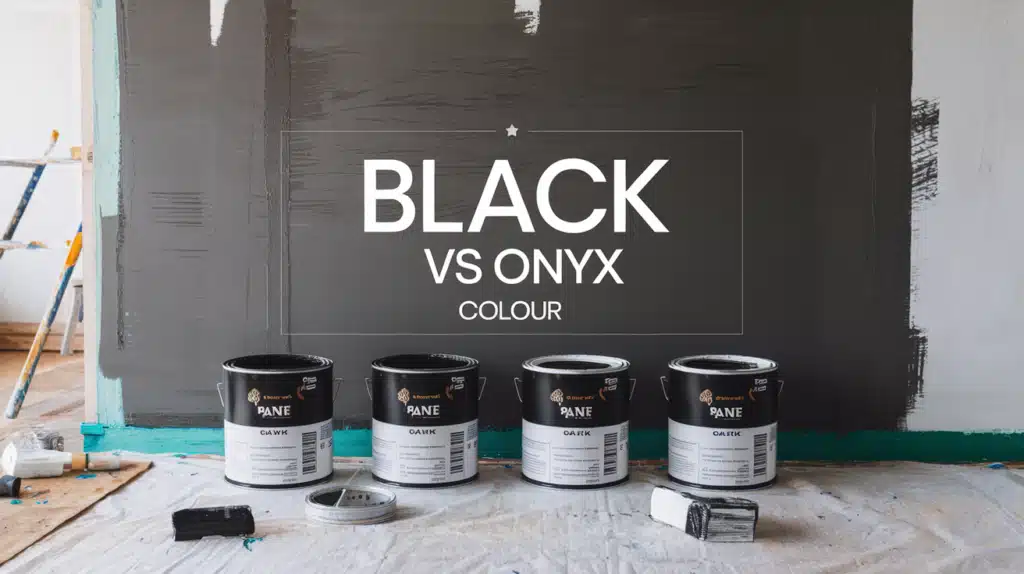Let me share what makes two distinct black paint colors stand out across multiple industries.
Having used both Benjamin Moore’s Onyx and Black, I’ve seen these shades make their mark in homes, car finishes, and fashion design.
I’ll explain why certain luxury car brands pick Onyx’s neutral depth for their signature finishes, while others opt for Black’s subtle cool tones.
From living room walls to evening wear and custom car paint to statement furniture – these two blacks create notably different effects.
In this side-by-side look, we’ll examine how each shade shows up across different materials, lighting conditions, and uses.
Whether you’re planning to paint a room, thinking about a car repaint, or interested in color theory in fashion, you’ll see exactly what sets each black apart.
Understanding the Colour
Let’s start with the basics of what makes these two blacks different – it’s more interesting than you might think.
Benjamin Moore Onyx 2133-10 has a Light Reflectance Value (LRV) of 4.99, while Benjamin Moore Black 2132-10 sits slightly darker at 4.56 LRV.
Though this difference seems tiny, it creates notable variations in how each color appears in real life.
Basics About Onyx

- Onyx carries a wonderfully balanced character – imagine a black that doesn’t lean too warm or too cool. When I opened my first can of Onyx, I noticed it looked almost charcoal-like when wet, but it dried to a rich, pure black.
- It is special because it maintains its neutral stance under different lights.
Basics About Black

- On the other hand, Benjamin Moore Black brings subtle blue notes to the party. Think of it as the black that adds a bit more drama.
- Its slightly lower LRV means it absorbs more light, making it appear a touch deeper than Onyx.
I find these technical details fascinating because they explain why two seemingly similar blacks can look so different when applied. The numbers tell us what our eyes might miss at first glance – Onyx offers more light play, while Black creates more depth.
Comparison Between Black & Onyx
When put side by side, these blacks show their true colors, so to speak. Let’s break down the key differences I’ve noted through my projects and research.
| Aspect | Onyx | Black |
|---|---|---|
| Undertones and Character | Neutral, balanced like a well-balanced espresso, neither bitter nor sweet. | Slight blue undertones are more noticeable under natural daylight, especially next to warm colors. |
| Versatility | It pairs well with both warm and cool colors and works beautifully with Cloud White and natural wood tones. | It partners better with cooler color schemes due to its blue undertones. |
| Warmth and Coolness | Balanced temperature, looks warmer with natural wood tones and cream whites, but composed with cool grays and bright whites. | Cooler due to subtle blue undertones, it becomes more noticeable in bright daylight, like a night sky before complete darkness. |
| Material and Finish | On Wood: Soft presence, allowing the wood grain to show through. | On Wood: Strong contrast, emphasizing wood grain patterns. |
| On Metal: Neutral, complements brushed and polished finishes. | On Metal: Adds depth, especially on matte surfaces. | |
| On Fabrics: Holds color well without looking flat. | On Fabrics: Creates dramatic shadows and folds. | |
| Appearance Under Different Lights | Natural Daylight: Stays neutral and true to its character. | Natural Daylight: Blue undertones become visible. |
| Artificial Lighting: Reflects warm lighting nicely, maintaining its black identity. | Artificial Lighting: Appears darker and more intense. | |
| Evening Light: Softens gracefully as the light fades. | Evening Light: Creates strong silhouettes and dramatic shadows. | |
| Multiple Light Sources: Adapts well to mixed lighting. | Multiple Light Sources: Shows more variation between lit and shadowed areas. |
Certain Application-Specific Insights to Follow
These two black paints create distinct moods in various situations, making them suitable for different design goals.
Through experience and study of real projects, I’ve seen how each black carves its own niche.
Let’s examine where each one shines.
1. Interior Design and Paint

Many homeowners choose black and onyx colors for their walls and fixtures. Both tints make spaces stand out and add depth to rooms.
When painted well, these colors draw your eye and set the mood right away.
Onyx Has Proven Its Worth in Multiple Settings
- Smaller spaces like bathrooms where it adds depth without closing in the room
- Home offices, where it’s easier on the eyes during video calls
- Kitchen cabinetry, especially when paired with white countertops
- Window trims, which frame views without competing for attention
Black, Shows Its Strength In
- Statement walls that need maximum impact
- Built-in shelving units where depth matters
- Exterior accents requiring strong definition
- Modern interior doors seek contrast
Benjamin Moore Onyx (2133-10) vs. Other Black Paints
| Comparison | Onyx (LRV 4.99) | Other Black Paints |
|---|---|---|
| Onyx vs. Black (LRV 4.56) | Slightly higher LRV, more neutral and balanced. | Slightly lower LRV, with subtle blue undertones for a cooler appearance. |
| Onyx vs. Wrought Iron (LRV 8) | Deeper, more impactful black. | Softer and lighter black is better for a gentler approach. |
| Onyx vs. Tricorn Black (LRV 3) | Neutral and versatile, less intense. | Maximum depth and darkness for bold applications. |
| Onyx vs. Iron Ore (LRV 6) | More neutral and versatile. | Slightly lighter, with warm undertones for a softer and warmer appearance. |
When to Choose Onyx Over Black
- Your room gets lots of natural light, and you want to maintain its brightness
- You’re coordinating with both warm and cool colors in the same space
- Working with natural wood tones or warm whites
- Creating contrast without harshness
- Planning to use the color on multiple surfaces throughout a space
Skip Onyx In
- Rooms with minimal lighting where you need to see details clearly
- Spaces like laundry rooms where task lighting is crucial
- Areas where you want the deepest possible black appearance
2. Fashion and Style

In the world of fabrics and fashion, these two blacks create subtle yet significant differences that catch the trained eye.
Their unique properties affect how garments drape, catch light, and convey messages. Let’s see how both play their parts in the style scene.
Onyx vs. Black in Clothing
The neutral nature of Onyx brings interesting qualities to clothing:
| Category | Onyx | Black |
|---|---|---|
| Natural Fibers | Cotton: Maintains depth without looking washed out. | Pleats/Folds: Creates sharper shadows. |
| Wool: Shows texture while keeping its richness. | Spotlights: Offers more dramatic contrasts under bright lights. | |
| Silk: Creates subtle light play without blue hints. | Photographs: Shows deeper saturation, ideal for capturing vivid contrasts. | |
| Linen: Ages gracefully, retaining its dark character. | Patterns: Makes stronger statements in pattern mixing. | |
| Material Performance | Better at hiding fabric texture variations. | More likely to show fabric wear patterns. |
| More forgiving of different fabric weights. | Creates stronger silhouettes for bolder fashion statements. |
Symbolism and Impact
Onyx carries distinct messages:
- Subtle power rather than stark authority
- Quiet confidence over bold statements
- Approachability while maintaining the presence
- Versatility across different social settings
Black Speaks Differently
- Projects classical authority
- Suggests artistic or creative leanings
- Creates immediate visual impact
- Commands attention in formal settings
Each shade lets wearers say something unique, even while staying within the black family. The choice between them often comes down to the message you want to send and the setting where you’ll wear the piece.
3. Automobile

In the automotive world, black isn’t just black – it’s a statement. Car manufacturers spend years perfecting their black finishes, and these two shades offer distinct characteristics that can make or break a vehicle’s appearance.
Onyx Black vs. Obsidian Black Car Paint
| Aspect | Onyx | Obsidian Black |
|---|---|---|
| Automotive Characteristics | Shows more nuance in curved body panels. | Makes body lines appear sharper. |
| Creates softer reflections in sunlight. | Shows deeper shadows under direct light. | |
| Maintains colour richness even in overcast conditions. | Creates mirror-like reflections when clean. | |
| Less likely to show minor dust and water spots. | More dramatic in showroom lighting. | |
| Paint Behavior Over Time | Ages gracefully, hiding minor scratches better. | Keeps its mirror-like finish longer with proper maintenance. |
| Shows fewer swirl marks from washing. | Maintains a wet-look appearance longer. |
Choosing the Right Shade for Your Vehicle
Both colors need proper care, but choosing between them often depends on your car’s primary use and your willingness to maintain that perfect finish.
Luxury Sedans
- Onyx works well on larger body panels
- Suits classic designs with flowing lines
- Complements chrome trim nicely
- Better for daily drivers
Sports Cars
- Obsidian emphasizes athletic body lines
- Makes carbon fibre accents stand out
- Creates dynamic light play in motion
- Perfect for show cars
Practical Factors
- Climate conditions in your area
- Parking situation (covered vs. uncovered)
- Maintenance routine and frequency
- Local environmental conditions
Psychological and Symbolic Differences
These two dark tones affect our minds and emotions in distinct ways. Pure black often makes people think of power, control, and high-end luxury. It’s bold and direct, setting clear boundaries in spaces.
Emotional Responses to Onyx vs. Black
- Pure Black Tends to spark strong initial reactions. Some people find it bold and definite, while others might feel it’s too stark. It commands attention and makes a clear statement about boundaries and strength.
- Onyx Colour Creates a more subtle emotional impact. Its slight softness helps people feel more at ease, similar to how a dark grey blanket might feel more comforting than a pitch-black one. in home settings, many find it less imposing while still maintaining visual impact.
Cultural Significance and Meanings
Pure black carries deep cultural weight across societies. It often represents:
- Authority and power in business attire
- Solemnity on formal occasions
- Sophistication in fashion
- Finality and certainty in written communication
Onyx, as a natural stone, connects to different cultural threads:
- Ancient Roman and Greek art used it in carvings and jewelry
- Traditional chinese medicine values it for stability
- Some cultures see it as a shield against negative energy
- Many associate it with inner strength and calm
In modern homes, these meanings still echo. A pure black wall might create a sense of authority in a home office, while an onyx-colored feature could bring a feeling of natural stability to a living space. The choice between them often comes down to the emotional atmosphere you want to create.
Think of It This Way: black is like a period at the end of a sentence – clear and final. Onyx works more like an ellipsis… suggesting there’s more to see and feel.
Conclusion
When choosing between these two dark colors for your space, car, or wardrobe, consider how each shade creates its own mood.
Pure black Makes a powerful statement with its clear boundaries and timeless presence. Meanwhile, the subtle warmth in Onyx Adds comfort while maintaining sophistication.
Both options carry unique weight in design. Your choice might depend on natural light, surrounding materials, or the feelings you want to create in your space.
From car finishes to wall colors, each shade brings its own character. What’s your experience with these colors?
Share your thoughts in the Comments About how you’ve used these shades in your home, car, or fashion choices.

